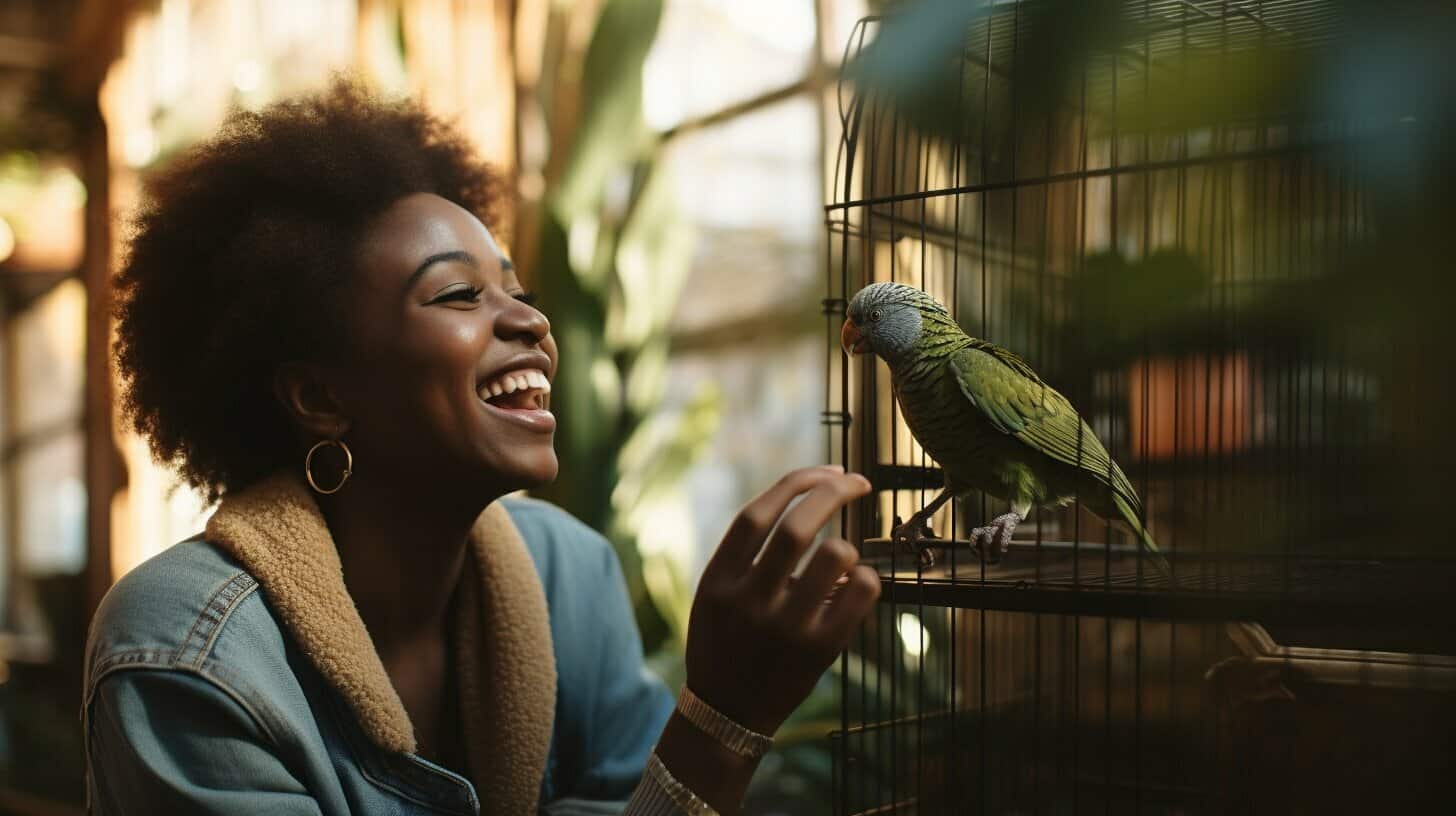Welcome to our guide on how to bond with a kakariki. Connecting with your pet bird can be a truly rewarding experience that can enhance your overall relationship and create a strong, lasting bond.
In this article, we will provide you with expert tips on connecting with your kakariki and building a trusting relationship.
Whether you’re a new kakariki owner or you’re looking to strengthen your existing bond, we’ve got you covered.
Let’s dive in and explore the best practices for nurturing a deep and meaningful connection with your feathered friend.
Understanding Your Kakariki’s Personality
Bonding with your kakariki requires understanding their unique personality. These birds have individual quirks, preferences, and tendencies, so observing their behaviour is important to develop a strong bond.
Tip: Observing your kakariki before attempting to interact with them is helpful. This allows you to gauge their mood and comfort level.
Observing Body Language and Vocalisations
Body language is an important aspect of your kakariki’s personality. Pay attention to how they move, perch, and interact with their surroundings. Observing their body language lets you learn a lot about their mood and comfort level.
Vocalisations are another important aspect of your kakariki’s personality. They use their voice to communicate a range of emotions, such as happiness, fear, and excitement. You can learn how to respond to their needs and build trust by paying attention to their vocalisations.
Expert tip: When your kakariki is making quiet, contented sounds, it’s a sign that they are relaxed and comfortable. When they are making loud, screeching sounds, it’s a sign that they are stressed or frightened. Pay attention to these vocal cues and adjust your behaviour accordingly.
Patience and Consistency
Bonding with your kakariki requires patience and consistency. These birds are sensitive and can be easily stressed by sudden changes or disruptions in their routine. You can help your kakariki feel comfortable and build trust by providing a consistent environment and a predictable routine.
It’s important to remember that bonding takes time and effort. You may not see immediate results, but you can develop a strong bond with your kakariki over time with patience and consistency.
Creating a Comfortable Environment
Creating a comfortable and secure environment for your kakariki is key to building trust and a strong bond with your bird. A happy and content bird is more likely to seek interactions with you and be receptive to training and socialisation.
| Tips for a Comfortable Environment: |
|---|
| Provide a suitable cage size, taking into account the wing span and tail length of your bird. |
| Use natural perches of varying sizes to promote foot health and exercise. |
| Offer bird-safe toys that stimulate your kakariki’s natural instincts to play and forage. |
| Place the cage in a warm, well-lit area of the house, away from drafts and direct sunlight. |
| Establish a routine for your bird, including regular feeding times and a consistent sleep schedule. |
Remember, providing a comfortable environment is just the start. Spend time interacting with your kakariki daily and observe their behaviour to understand their needs and preferences better. Consistency and patience are key to building trust and nurturing a strong bond with your feathered friend.
Using Positive Reinforcement
Positive reinforcement is a powerful tool for establishing a bond with your kakariki. You can encourage your bird to repeat these actions and build trust and respect by rewarding desirable behaviours.
When using positive reinforcement, choosing rewards that your kakariki enjoys is important. Fresh fruit, vegetables, and seeds can be great motivators, as can verbal praise and scratches behind the head.
Timing is also important when using positive reinforcement. Rewarding your kakariki immediately after they exhibit the desired behaviour is essential, so they associate the action with the reward. Consistency is also key – use the same rewards every time and follow through on promises.
Positive reinforcement can be used in a variety of ways to build a bond with your kakariki. For example:
| Behaviour | Reward |
|---|---|
| Stepping up onto your hand | Small piece of fruit |
| Playing with a new toy | Praise and head scratches |
| Learning a new trick | Favourite treat |
Remember, positive reinforcement should always be used in conjunction with other bonding techniques, such as spending time with your kakariki and providing a comfortable environment. Combining these strategies can build a strong, loving bond with your pet bird.
Socialising with Your Kakariki
Socialisation is an essential part of building a bond with your kakariki. By interacting with your bird on a regular basis, you can develop a deeper understanding of their personality and preferences and establish trust between you.
Here are some tips for socialising with your kakariki:
- Spend time in the same room as your bird, talking to them and letting them get used to your presence.
- Allow your kakariki out of their cage under supervision, so they can explore their environment and interact with you.
- Offer your bird a range of toys and perches to keep them entertained and stimulated.
- Pay attention to your bird’s body language and vocalisations, so you can understand their moods and respond appropriately.
Each kakariki is unique, so observing their behaviour and adapting your approach is essential. Some birds may be more outgoing and playful, while others may be more reserved and need time to build trust. By getting to know your bird, you can develop a strong and rewarding relationship that will last a lifetime.
Training Your Kakariki
Training your kakariki can be an effective way to bond with your bird. It not only helps stimulate their mind but also allows you to establish a connection through positive reinforcement. Here are some tips for effective training:
- Start with simple commands: Begin with simple commands like “step up” or “come”. Use a treat to reward your bird for following the command.
- Be consistent: Consistency is key when it comes to training. Practice the same command every day, and use the same reward each time.
- Use positive reinforcement: Positive reinforcement is a great way to encourage your bird to continue learning. Use treats, praise, and affection to reward good behaviour.
- Set realistic goals: Set achievable goals for your bird and work towards them gradually. Don’t expect your kakariki to learn complex tricks overnight.
- Be patient: Patience is essential when training your bird. Allow your kakariki to learn at their own pace and avoid becoming frustrated or angry.
- Enlist help if needed: If you’re having trouble training your bird, don’t hesitate to seek professional help. An experienced bird trainer can offer valuable advice and guidance.
Remember, training should always be a positive experience for both you and your kakariki. Using these tips, you can help foster a strong bond with your bird and have fun.
Providing Proper Nutrition and Care
Proper nutrition and care are key factors in fostering a strong bond with your kakariki. By ensuring your bird’s basic needs are met, you can create a safe and comfortable environment that allows them to thrive. Here are some tips for providing the best possible care for your feathered friend:
| Tip | Description |
|---|---|
| Choose a suitable diet | Your kakariki’s diet should consist of a variety of foods, including commercial bird food, fresh fruits and vegetables, and occasional treats like seeds or nuts. Avoid feeding your bird anything that is toxic or harmful, such as chocolate or avocado. |
| Provide fresh water daily | Your kakariki should always have access to fresh water. Change their water dish daily, and make sure it is clean and free of debris. |
| Keep their environment clean | Clean your kakariki’s cage regularly, removing any droppings or debris. Replace bedding and toys as needed. A clean environment is important for your bird’s health and wellbeing. |
| Allow for regular exercise | Kakarikis are active birds and require regular exercise to stay healthy. Provide plenty of opportunities for your bird to move around and play, both inside and outside of their cage. |
| Schedule regular veterinary check-ups | Regular veterinary care is essential for your kakariki’s continued health. Schedule annual check-ups with a qualified avian veterinarian to ensure your bird is in good health and catch any potential issues early on. |
You can help foster a strong bond between you and your feathered friend by providing proper nutrition and care for your kakariki. Remember to always put your bird’s needs first, and enjoy the journey of growing closer to your pet!
Avoiding Negative Interactions
Just as positive reinforcement can build a strong bond with your kakariki, negative interactions can quickly erode that trust and connection. It is essential to understand how your bird perceives the world and avoid behaviours that may scare or stress them.
Sudden movements, loud noises, and other intense stimuli can cause your kakariki to feel threatened or anxious. You can help prevent negative interactions by moving slowly and calmly around your bird, speaking in a soft tone, and avoiding sudden movements.
Respecting your bird’s personal space is also crucial. Avoid reaching into their cage or forcing them to interact with you. Instead, provide plenty of opportunities for your bird to approach you on their terms, such as offering treats or talking to them from a distance.
If your kakariki displays signs of aggression, fear, or other negative behaviours, take a step back and assess the situation. Determine what may have triggered the behaviour and try to avoid similar situations in the future. Seek professional help if necessary.
“Avoiding negative interactions with your kakariki is key to building a strong bond and fostering a happy, healthy relationship.”
Building Trust with a Shy or Traumatised Kakariki
Bonding with a shy or traumatised kakariki can be challenging, but it’s not impossible. It often requires additional patience, time and effort. Here are some tips to help you build trust with your bird:
Be Patient and Respectful
Building trust will likely take longer if your bird is not used to human contact or has experienced trauma. Respect your bird’s boundaries and don’t force interaction. Approach your bird slowly and calmly, and give them time to get used to you being around.
Don’t make sudden moves, loud noises or try to grab your bird. Instead, let them come to you at their own pace. Offer treats or favourite foods to encourage positive associations with your presence.
Create a Safe and Comfortable Environment
Providing a secure and comfortable environment for your bird is essential for building trust. This includes a suitable cage, perches at different heights and textures, and toys for mental stimulation.
Place the cage in a quiet area away from loud noises and distractions. Avoid moving the cage frequently, as it can cause stress and anxiety for your bird.
Use Gentle and Consistent Training Techniques
Training your bird can help to build trust and confidence. Start with simple commands such as “step up” and “come,” using positive reinforcement such as treats or praise.
Be consistent with your training and avoid punishments or negative reinforcement, as this can lead to fear and mistrust. Avoid overtraining and keep sessions short and enjoyable.
Seek Professional Help if Needed
If your bird’s trauma is severe, or you’re struggling to build trust despite your efforts, seek professional help from a veterinarian or bird behaviour expert.
They can provide advice and support tailored to your bird’s specific needs and help you establish a strong bond with your kakariki.
How to Bond With a Kakariki: FAQ’s
Building a strong bond with your kakariki takes time and patience. Here are some frequently asked questions about bonding with these intelligent and playful birds:
How long does it take to develop a bond with a kakariki?
The bonding process can vary depending on the individual bird’s personality and experiences. Some kakarikis may be more outgoing and eager to interact, while others may take longer to warm up to their owner. It’s important to approach the bonding process with consistency and patience, and to understand that it may take weeks or even months to develop a strong bond.
What can I do if my kakariki seems uninterested in bonding?
If your kakariki seems uninterested in bonding, it’s important to approach the situation with patience and understanding. Try providing a comfortable and secure environment, offering treats and positive reinforcement, and spending time talking and interacting with your bird. If your bird is particularly shy or traumatised, seek the help of a professional bird trainer or behaviourist.
Can I socialise my kakariki with other birds?
While some kakarikis may enjoy the company of other birds, others may become territorial or aggressive. It’s important to observe your bird’s behaviour and body language when introducing them to other birds, and to provide supervision during socialisation. Keeping your bird in a separate enclosure may be best if it seems stressed or uncomfortable during socialisation.
What should I do if my kakariki bites me?
While biting is a common behaviour for kakarikis, it’s important to discourage this behaviour through positive reinforcement and consistent training. If your bird does bite you, try not to react with fear or anger, as this may reinforce the behaviour. Instead, calmly remove your hand and provide positive reinforcement for good behaviour.
How can I tell if my kakariki is happy and comfortable?
A few signs may indicate your bird is happy and comfortable, including relaxed body language, vocalisations such as chirping or singing, and playful behaviour like head bobbing or wing flapping. Regularly observing your bird’s behaviour and body language is important to ensure they are happy and healthy.
Building a strong bond with your kakariki takes time and effort, but the rewards are well worth it. You can form a deep and rewarding relationship with your feathered friend by providing a comfortable environment, offering positive reinforcement, and spending time socialising and training your bird.



Have comments or questions about this article? Then get involved!
Spotted an error or something we have missed? Let us know